Cratons: stress melting during the Shock Dynamics event
Cratons are considered to be the oldest parts of continents, but are they? This page will present detailed information from professional geologic journals, and then offer a Shock Dynamics perspective. While all the material is useful, that which is highlighted in red is most important for the new interpretation.
In the geologic time scale, the oldest eon is called the Archean, with an assigned age of 2.5 billion years ago and older. The Proterozoic eon is the next younger on the time scale, with assigned age range of 2.5 billion to 542 million years ago. The Archean and Proterozoic eons together make up the Precambrian; all the rest of the geologic time scale is Phanerozoic. Most cratons are considered to have formed during the Archean. "Archean cratons are relatively flat, stable regions of the crust that have remained undeformed since the Precambrian, forming the ancient cores of the continents."23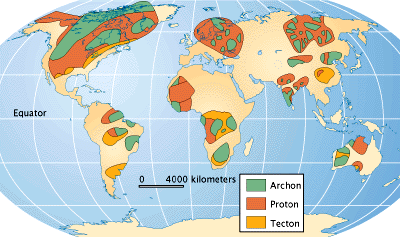
One
person's conception
Sometimes a shortened name is used:
Archon=Archean+craton; Proton=Proterozoic+craton. "Archons are areas
where the last major tectonothermal event to affect the upper crust was >2.5
billion years ago; Protons experienced their last ... event between 2.5 and 1.0
billion years ago; and Tectons are typically underlain by different types of
[sub-continental lithospheric mantle] SCLM... toward less depleted SCLM through time."15 SCLM
is the lowermost part of a plate below a continent. From Archean to
Proterozoic to Phanerozoic time, SCLM has become progressively less depleted in
terms of Al, Ca, Mg# and Fe/Al.9
"One of the defining features of
Archean cratons is the presence of a thick (>150 km) lithospheric mantle
keel"7
or lithospheric root, sometimes called "tectosphere", with a thick thermal
boundary layer about 200-250 km deep.25
A thick chemical boundary
layer extends to 150-175 km deep, made buoyant by high degrees of melt
depletion.25 "Below 175 km, the mantle becomes more fertile."23
"Cratons are characterized by the lowest surface heat flow of any
province on Earth."5
Isopycnic hypothesis
Even though
lithospheric roots beneath Precambrian cratons are colder than younger
lithosphere (continental or oceanic), cratons do not show positive gravity
anomalies (sinking).21
To explain the contradiction, the isopycnic (equal-density) hypothesis
was proposed: the density increase which
should make it sink is compensated by chemical depletion (mainly in Fe and Al)
that makes it lighter (more buoyant) than the mantle around it.21
This hypothesis has melt-depleted peridotite chemical buoyancy exactly balancing
extra cratonic density (isostatic equilibrium).25
Experimental
studies generally support this idea, showing cratonic lithosphere is less dense
than non-cratonic upper mantle by up to 1.5-2.5%21,
and the isopycnic
hypothesis has been generally accepted.
However, this view has fundamental problems:
-
The continental lithosphere is believed to have cooled over time
relative to the surrounding mantle. So a craton would have to increase its
buoyancy to exactly balance increasing density.25
-
The density
increase from low temperature is only partly (about 40%) compensated by
compositional buoyancy.21
"There are
significant differences in the density of cratonic roots, even for those of
similar age. Root density depends on temperature and chemical depletion."21
In cratonic roots, temperatures vary strongly. Density variations due
to temperature are larger than those due to chemical differences.21
- "Variations in surface heat flow are largely controlled by local
variations in upper-crustal heat production, and are not reflected in large
temperature variation at mantle depths."15
Studies of peridotites from Kaapvaal craton do not follow the expected density-with-depth curve: shallow ones are less dense, while deep (>120 km) high-temperature ones are denser than isopycnic predictions. Peridotite xenoliths from Slave and Tanzanian cratons show a steeper-than-predicted density increase with depth.21
Furthermore, the neutral buoyancy of cratons has been challenged. "After subtracting pure crustal isostasy from observed topography, we find that cratons are generally depressed by about 300 to 1500 meters."30 Northern Eurasia is strongly depressed; large parts of Eurasia, South America, and North America are depressed by about 300 meters. Western North America, southern Africa, western Europe, Greenland, and eastern Asia are not.30
Even if it were correct, the "isopycnic hypothesis provides no direct insight into craton origin."25
Stability
In the current
view of the Earth, there is a constant churning from the depths
to the surface and back down, recycling the material. Yet
cratons are thought to have survived from the most ancient
times. This is probably the most persistent problem geologists
have with cratons. "The apparent
stability of Archean cratons and cratonic keels for billions of years is a
difficult observation for geodynamic modeling to explain.23
"It has
been quite challenging to produce geodynamical models that maintain stable
cratonic keels in a convecting mantle over several billion years of mantle
evolution."23
"Most geodynamic models have difficulty preserving
continental lithosphere for even a fraction of the ages... [of] many Archean
lithospheric sections."5
"Even the large density differences... in
oceanic lithosphere between crust and mantle following subduction apparently can
be mixed away by mantle convection over billion year time periods."5
"In numerical studies, strong and buoyant cratonic keels survive
relatively undeformed for several mantle overturn times (equivalent to several
hundred million years); extending this to several billion years remains a
challenge."23
Chemical buoyancy cannot prevent recycling.27 "Numerical studies have clearly demonstrated that neutral buoyancy is not sufficient to stabilize cratonic keels from the shearing of mantle flow.23 Buoyancy alone is ineffective to deter entrainment. "The chemical layer of lithosphere needs to be significantly more viscous... than the underlying mantle to remain stable."36
"Melt depletion... leaves the mantle lithosphere depleted in radioactive heat producing elements and in water... low temperature and low water content of cratonic mantle lithosphere can lead it to have a viscosity as much as 3-4 orders of magnitude higher than warm, wet asthenospheric mantle."5 Yet "stabilizing the cratonic root requires it to be significantly more viscous than can be explained by dehydration or melt depletion alone."23
Research is challenging the neat definitions of cratons. "Generalizations of Archean cratons do not capture the variability between cratonic regions or the complexity within a single craton assemblage. For example, not every craton is underlain by high-velocity roots, and the deepest roots do not always occur under Archean cratons."23 "There is [as] yet no clear theory for why some cratonic roots appear to be deformed during rifting or compressional events while other cratonic roots appear to resist similar deformation events."23 "Other questions regarding cratons and mantle dynamics that remain unsolved are how cratons form, when cratonic roots formed, and why cratons appear to have formed early in Earth evolution and not now."21,23,26,36
"Cratonal lithosphere is significantly thicker than old oceanic lithosphere, yet much thinner than it would be if it had simply cooled from above by conduction since the Archean."36 While the thickness of thermal boundary layers of Archean cratons (>2.5 billion years old) is 200-300 km, the thickness predicted by conductive cooling is 400-500 km.26 "If the mantle cooled significantly, ~150 K, since the Archean... the vigor of convection should wane over time and the lithospheric thickness... should increase."36 Conductive cooling would also require subsidence of the surface to the point that the cratons should either be under water or should have overlying sedimentary layers more than ~5 km thick, neither of which is observed."22
Craton formation
Some researchers have
concluded that it requires a "uniquely Archean process involving high-degree
melting at depth" to make Archean SCLM, and that modern plate
tectonics do not apply to its formation. Such a process no longer
operates on a large scale in the Earth.16
However, zircons "strongly suggest... that within ~100 million years of
[Earth's] formation [as early as 4.35 billion years ago], Earth had settled into a pattern
of crust formation, erosion, and sediment recycling similar to that produced
during the known era of plate tectonics."41
There are 3 main ideas for
the formation of cratons:
1) The Rodinia supercontinent is supposed to have
accreted during the Grenvillian event ~1300-1000 million years ago from "all
existing continental fragments of that time." Accretion was
typically "soft" collisions which did not lead to extensive crustal thickening,
metamorphic grades remained relatively low, and there was not extensive uplift.
Signs of accretion have mostly been eroded away, leaving a "sea"
of complexly deformed amphibolite- to granulite-facies migmatitic gneisses.24
"Of modern
mantle samples, only those sampled at island or continental arcs approach the
degree of depletion of cratonic peridotites."5
"Oceanic mantle has also experienced melt extraction, although not
to the very high extent seen in cratonic mantle."26
The main problem with the oceanic accretion hypothesis is that oceanic lithosphere gets denser as it cools, and is subductable after only 20 million years.25
If chemical boundary layers form beneath continents from oceanic lithosphere or arcs, and "if these lithospheric segments are initially dry, a paradox arises because they should be strong and not easily deformed. If they are wet or rehydrated to make them weak enough to deform and make cratons, another paradox arises because a chemically buoyant boundary layer, without being intrinsically stronger, would eventually thin out gravitationally."26
Also, "there has been much debate in recent years on the existence, configuration and evolution of the supercontinent Rodinia."24 Paleomagnetic data do not support the idea. For example, one study concluded that "African, southern Indian, and South American cratons were not part of the Rodinia supercontinent."24
2) Another common model involves stacking subducted slabs of oceanic or arc-related mantle under continents. This fails because modern examples are not compositionally like Archean SCLM, and there is no evidence that Phanerozoic SCLM is made that way.16 This model requires the SCLM to be deformable at the time of formation, and soon afterward become strong enough to resist shearing.23 It is also not clear why stacked subducted crust "would lead to roots between 200-300 km deep and no deeper, or why there appears to be a unique period in Earth history when cratonic roots formed."23 "The geochemical evidence is consistent with the hypothesis that the roots are the residue of partial melting, which is difficult to reconcile with the stacked subducted slab hypothesis."23
3) The thick, depleted chemical boundary layer
beneath cratons implies formation by melting of upwelling mantle much hotter
than that found today.26
The entire craton could be formed in one
large heating event, such as a plume-melt. "A thick, strong, and chemically
buoyant mantle keel can be generated by one seemingly simple and elegant
process."25
Along with high degrees of melt extraction should be
large amounts of complementary ultramafic magma.25
"A single step of high-degree melting of
the mantle produces a high-magnesium magma known as komatiite." "But its
abundance even in the Archean crustal record is grossly insufficient to balance
the amount of highly depleted peridotite found in cratonic mantle."5
High degrees of melt extraction would have dehydrated cratonic
mantle.25 Deeper mantle is
thought to percolate up (metasomatize, i.e. fluids adding minerals to rocks) low-temperature volatile
components, like Fe.2
Although
"metasomatic events do not pervade most cratonic uppermost
mantle,"8
many cratonic mantle xenoliths indicate hydrous metasomatism
. Yet
rehydration might lead to weakened continental lithosphere and recycling back to
"convecting mantle."25
Finally, "there is no gradual decrease in fertility with
increasing depth." Evidence suggests that cratonic mantle is not the residual
mantle column of a plume head.25
Collision belts
"The late tectonic evolution of Archean cratons... is complex and involves extensive rifting, magmatism, compressional
deformation, and metamorphism."7
Collision belts are around nearly every Archean cratonic
block.28
Slightly dipping reflections in the crust and upper mantle
seen in deep seismic reflections from the Superior and Slave cratons in Canada
and the Yilgarn craton in Australia "indicate that peak orogenesis [mountain
building] leading to
cratonization was dominated by horizontally directed forces"38.
"Many of the features characteristic of collision belts"... "are no
longer preserved in the deeply eroded orogens."24
The assumptions
of plate tectonics are often applied to Archean or Paleoproterozoic orogens.
However, many of these ancient deformation belts differ by being mainly flat
with steep (vertical) transpressive zones. They may result from hot, weak
lithosphere spreading horizontally rather than thickening during convergence
towards more resistant lithosphere.4
Greenstone belts
Greenstone
belts are metamorphosed volcanic rocks (mafic to ultramafic), mostly
basalts, with sedimentary rocks interleaved. Many are associated
with cratons. "The greenstone belts
characteristic of the old parts of the Earth's crust could be formed by scraping
and folding of basalt-rich parts of the crust... or by infilling... with
volcano-sedimentary sequences."33
"South African Archean
greenstone belts... are shallow features which rarely exceed 7 km in depth."10
The Western Superior greenstone belts are shallow, <5 km, and
lack a "stratigraphic contact... with the underlying felsic basement."31
They
often contain gold, silver, copper, zinc, and lead ore. Pillow
lavas indicate rapid cooling by water.
Continental crust
Cratons
are considered to be the first continental crust, which is
above continental lithosphere because it is lighter.2
There are
distinct layers: The upper crust with hydrous, granitic rocks; the lower crust,
with dry, mafic (feldspar and amphibole rich) rocks. The crust has quartz, mica,
and feldspar-rich rocks, while the upper mantle is olivine-rich and stronger
than the crust.17
"Recent models of crustal evolution are based on the belief that the thickness of the continental crust is proportional to its age, with ancient crust being the thickest." One hypothesis for crustal growth is "that the crust is thickened by repeated episodes of basaltic underplating." "A worldwide review of seismic structure contradicts this belief and falsifies these models, at least for the Archean." "Proterozoic crust has a thickness of 40-50 km and a substantial high-velocity (>7 km/s) layer at its base, while Archean crust is only 27-40 km thick... and lacks the basal high-velocity layer."10
"Accumulating evidence suggests that in many areas, later reworking of the deep crust is more widespread than previously recognized."44 "A comparison of average Proterozoic crustal structure with highly evolved Phanerozoic crust that has undergone the full range of plate tectonic processes (from island arc to continental-arc volcanism) reveals a remarkable similarity."10
South African studies "indicate that the Archean crust was composed of granite (~70%) and a mafic component (up to 30%) which probably was komatiite." Compared to Proterozoic crust, "Archean rocks are depleted in Si and K and enriched in Na, Ca, and Mg. There is also a marked change in the Eu/Eu ratio." "Archean crust develops above mantle lithosphere (garnet lherzolite) that is depleted in FeO and intrinsically bouyant." "Proterozoic crust develops above fertile (normal FeO) mantle lithosphere (spinel herzolite)."10
Crust formation is getting granite from basalt.2 Primitive mantle differentiates to form continental crust, which is Al and Si rich, and so less dense, plus depleted mantle, which is Mg and Fe rich and denser.1 After mafic magmas differentiate, the crust and mantle segregate. Partial melting of the crust then refines the material, and further segregates the crust. This results in mature continental crust of intermediate to felsic material.3 Low-temperature liquid is extracted at each step, leaving a larger volume of solid residue.2
Upper crustal sediments are the source of
S-type granites; M-type granites are from mantle-derived basalts. But though
I-type granites are abundant, widely distributed, and diverse, origin is
uncertain. They make up a large portion of the continental crust.12
Instead of mantle melts, it is possible that I-type granite is formed by
high-degree melting of igneous rocks in lower continental crust.12
"Continental crust is thought to be formed as a result of arc
magmatism." "A fundamental problem is that the majority of magmas erupted on
Earth are basaltic and yet the continents do not have a basaltic bulk
composition." Those that are silicic (dacitic to andesitic) lavas are evolved,
with lower Mg#s than continental crust.20
The continental
crust is only 0.5% of the mass of the "bulk silicate earth" (BSE), yet it
contains ~35% of the radioactive elements K, U. Th, of the BSE. Thus it is
"enriched" by a factor of ~70. "This implies that at least 35% of the BSE passed
through whatever melting processes eventually formed the continents."35
Low-percent partial melts, like modern alkalic basalts, are
strongly enriched in light rare earths and depleted in heavy ones. Alkalic basalts may have added much of the K, U, Th to the crust.35
The continental crust [also] contains rubidium and barium... in quantities
equivalent to the rubidium and barium from 30-50% of that in the total mantle.5
Forming continental crust makes much residue. Crust is made by 20% partial melt. Residue from crust formation is about 5 times the volume of continental crust. So a 40 km thick crust leaves a 200 km thick restite. Restite is Fe-rich pyroxene/amphibole plus garnet, and has high density.2 "To generate bulk crust with a high Mg# andesite composition, some process is required to remove the cumulates and residues formed during generation of the silicic, "granitic" end-member."20
Granite magma
Granitic rocks form from a
balance of mantle and crustal components. Granite magmas are of
crustal origin. The standard paradigm is: granitic magmas melt in
the lower crust and ascend to the middle crust to build plutons.39
"The best way to extract a melt from its matrix is by compression and
shear." In experimental melting, "dehydration breakdown of
hydrous minerals (micas/amphiboles) results in a melt with granitic
composition." Water is liberated and immediately reincorporated to produce
magma. "At present, magma ascent as a whole body (i.e. diapirism)
is commonly considered to be unrealistic." "For magma, dyking is actually the
preferred model." "A forceful intrusion, with a major vertical
movement of the magma, is often unlikely in granite plutons." "The ascent must be in a locally extensional... setting."39
In a purely extensional stress field, alternating the directions of
horizontal stresses may lead to the formation of vertical and cylindrical
plutons.39
Komatiites
Cratonic mantle and komatiites are complementary products of high
degrees of melting of pyrolitic mantle.19
Komatiites form
from 30-50% melting of an essentially dry source.2,35
"Komatiite magmas must
have gravitationally separated from their residues to erupt as surface flows
that can now be observed on some Archean cratons."19
"Komatiites are not found in all cratons, and where they occur, basalts are a more common lithology."19 If komatiites form from ~25-50% melting of pyrolitic mantle, and the residues are in ~100km-thick (or more) cratonic roots, then ~35-100 km of complementary Archean crust should have been produced. "Where is all the komatiite?" "We have a paradox of mass balance requirement and geological observation." "The easiest way to resolve this paradox is by elimination of komatiite from the geological record."19 That is, to submerge it into the mantle.
Foundering
The boundary
between the lower crust and mantle may be open. When magmatic or
tectonic activity destabilizes and deforms the lithosphere, ultramafic cumulates
tend to move downward. This "foundering" occurs during orogeny,
rifting, and continental breakup.3
Crustal foundering builds continental crust. In continental crust we find Si, Al, incompatible enriched gabbro, and low density. Dense lower crustal ultramafic cumulates, carrying contaminants from the lower crust, find their way to the mantle.3
Intracrustal melting produces granitoid magmas and dense mafic restites that return to the mantle. The foundering of mafic restites from granitoid magmas is likely a major process.3
High temperature is required for dense lower crustal mafic-ultramafic cumulates to sink into the mantle. Results of experiments show that "an initial strain rate can significantly reduce the Moho temperature required for an instability to develop." "Instability times decrease because the initial effective viscosity is lower."20
Foundering in the crust is an alternative to proposals calling for the ascent of contamination up to the lithospheric mantle.3
Moho and sub-Moho boundary layer
The Mohorovicic
discontinuity (Moho) is defined as an abrupt increase in P-wave velocity to
>7.6 km s-1. "The Moho occurs at a nearly uniform depth of 5-8 km under the
seafloor." The "continental Moho is considerably deeper (20-85 km)."11
This indicates a
world-wide structural scale change near the Moho.13
Average Moho depth under Precambrian cratons is somewhat greater than
under Phanerozoic continents.21
The Moho marks
not only a jump in seismic velocity but a dramatic change in heterogeneity
dimensions.13
"The Moho is a global feature because the Earth is
chemically differentiated into crust and mantle on a global scale."14
"The high-velocity layer at the base
of the crust, in most cases, consists of high-grade metamorphic rocks with
intermediate to mafic compositions."10
"There is still no scientific consensus about its origin, petrologic significance, and structural context."11 One hypothesis "posits mechanical decoupling of the crust and uppermost mantle as a result of structural detachment at (or near) the Moho." "Under exceptionally hot conditions, lower crustal channel-flow behaviour can result in nearly complete decoupling of the... crust from the upper mantle."11 There could even be "a differential horizontal movement or decoupling of crust and upper mantle at the level of the Moho."13
"For a large majority of cases, the Moho transition is sharp (across only a few kilometers)." If the transition is due to the gabbro-to-eclogite transition, it should be gradual. It is "more likely a break between mafic crustal compositions and underlying ultramafic mantle."20 "We can then ask, if the Moho depth is not simply the result of a pressure sensitive phase transition from gabbro to eclogite, why does the thickness of the crust vary only between 25 and 40 km worldwide?"20
High-resolution seismic observations show a sub-Moho boundary layer (SMBL) at the top of the lithospheric mantle. SMBL thickness is 60-100 km. "High-frequency seismic phases traverse geological provinces of various age, heat flow, crustal thickness, and tectonic regimes. Their propagation appears to be independent of age, temperature, pressure, and stress."14 The SMBL acts as a waveguide. It is connected to the Mohorovicic discontinuity, a global phenomenon.14 "Differential horizontal deformation between crust and mantle near the Moho is the most likely explanation for the creation of seismic velocity fluctuations within the SMBL."14
Flood
basalts
Flood basalts are eruptions of millions of cubic kilometers of
basalt that can spread "in less than 1 million years."34
They are often related
to continental
breakup. Parana, Karoo, and Deccan flood basalts came with the breakup of
Gondwanaland. Some flood basalts are "associated with rifting in stable
cratons that does not lead to breakup", such as the Mid-Continent Rift in North
America, or Ventersdorp Rift in southern Africa.34
Flood
basalts are "not predicted by plate tectonics"; "their origin remains
enigmatic."34
Several Precambrian massive outpourings or intrusions of continental flood basalts occurred in southern Africa. Ventersdorp covers much of Kaapvaal. Bushveld is the world's largest layered igneous intrusion, and was injected rapidly. The 500-km-long Great Dyke is likely the remnant of a large igneous province covering 60,000 km2. Eruptive basalts of the Soutpanberg Group are over 3 km thick, and are probably the eroded remnants of a Proterozoic Large Igneous Province.34
The rifting characteristics found at these places show that they are related to "collisional orogens." They were caused by "stress perturbations" in the lithosphere, "not melting due to deep-seated, high-temperature mantle plumes." Nor were they likely due to lithospheric thinning by thinning or delamination.34 "It is very difficult to find any evidence for delamination from the xenolith record of any cratonic environment worldwide." The only clear evidence is for the North China Craton.34
"We thus conclude that the presently accepted mechanisms for flood basalts - mantle plumes and lithospheric thinning - are incapable of accounting for the southern African Precambrian magmatic events."34 Cratonic flood basalts erupted quickly, perhaps from "abrupt stress change in the lithosphere", leading to "propagation of lithospheric dikes". This implies large reservoirs of magma.34
Low-Velocity Zones (low seismic velocity, indicating rock that is less-dense, perhaps hot)
"Low-velocity zones beneath stable [i.e. cratonic] continental regions tend to be either extremely weak or entirely absent. As a result the base of the continental lithosphere is not well defined by seismological data. With increasing depth the high seismic velocities of the stable lithosphere gradually" merge into mantle velocities.5
"A low-velocity zone at depths below ~100 km is a global feature of the continental mantle."37 "This zone may be caused by a partial melting, globally initiated at equal depth in the continental mantle. Solid state is again attained at the Lehmann discontinuity [220 km] in cold, stable areas, whereas the zone extends to near the 400-kilometer discontinuity in hot, tectonically active areas."37
"Low-velocity zones beneath cratonic lithosphere are not uncommon." They appear below the Kaapvaal craton, Canadian Shield, and Australian shield. "The low-velocity anomalies below these lithospheric roots, however, do not reach shear wave velocities below 4.4 km/s. By comparison, the dramatic excursion to β=4.20+0.05 km/s at 200-250 km below the surface of the Tanzanian craton is unique. These velocities are lower than velocities found at comparable depths beneath the East Pacific Rise spreading center and require unusually high temperatures and perhaps partial melting."42 Also, "the volume of igneous basalt in the eastern branch of the East African Rift system [is] estimated at greater than 900,000 km3."42
There is "evidence of a super-deep low-velocity layer in [both] the upper mantle of southern Africa and the Tunguska basin of the Siberian platform." "Three regions with evidence of this layer are remarkable for large-scale eruptions of continental flood basalts:" the Karoo flood basalt province in southern Africa, the Siberian traps in the Tunguska Basin (>2.5 million km2), and extensive flood basalts in Ethiopia and on the Arabian plate (30-20 million years ago (Ma)).40 "A correlation between the locations of the low-velocity layer and of the continental flood basalts up to 250 Ma old suggests that the layer migrates with the plates. While this is very surprising with respect to conventional wisdom, a similar conclusion was derived [for]... the Parana flood basalts 137-127 Ma old in South America."40 "A low velocity anomaly in the southern part of the Parana basin suggests that the Parana LIP might have been related to the upwelling of several plumes." However, why traces of them are still there "remains unclear".18
Special findings
"While
it seems clear that Archean sub-continental lithospheric mantle
peridotites must have formed at very high degrees of melt extraction,
controversy still revolves around the geotectonic environments that
allow melting to such extensive degrees. The two most widely
favoured geodynamic settings proposed for the generation of the
melting residues underlying cratons are large mantle plumes and
subduction zones, with or without prior melting at ridges."43
"Dehydration can lead to several order of magnitude increase in viscosity, relative to mantle at the same pressure and tempereature conditions." Cratonic keels could be the depleted residue from a large melting event.23 The entire craton could be formed in one large heating event, such as a plume-melt. "A thick, strong, and chemically buoyant mantle keel can be generated by one seemingly simple and elegant process."25
"In contrast to the varied and scattered major element systematics of cratonic peridotites in general, their heavy rare-earth element concentrations vary in a much more systematic and more easily interpreted manner." "Mildly incompatible trace elements offer much more promise in terms of providing geodynamic information about the original Archean melting regime. The very low, systematically varying heavy rare-earth element abundances in the North Atlantic Craton whole-rock peridotites and in peridotites from all other cratons where high-quality data are available provide ubiquitous evidence for a shallow melting regime in the absence of, or to the exhaustion of garnet. This finding explicitly excludes large extents of deep... melting." "This and all other craton locations investigated so far contain peridotites that experienced melting in shallow environments."43
The data show that "peridotites whose history is dominated by shallow melt extraction [are] dispersed throughout the entire depth of the deep cratonic root." "Our conclusions... for the North Atlantic Cratonic lithosphere agree with those of other workers who have concentrated on the Kaapvaal craton." "We can extend these conclusions to other cratons where reasonably large numbers of major and trace element data are available such as the Siberian, Slave, Rae province, Wyoming and Tanzanian cratons."43
"Heavy rare-earth element concentrations of North Atlantic Craton whole-rock peridotites are consistently lower than those of primitive mantle. In order to reproduce these low heavy rare-earth element concentrations, modelling demands that polybaric fractional partial melting took place in the absence or in the presence of only small amounts of garnet (<3 GPa), similar to shallow melting regimes currently operating in the Earth's mantle." "The abundant heavy rare-earth element-enriched peridotites predicted for plume-melting are not observed in the North Atlantic Craton or any other craton." The North Atlantic Cratonic sub-continental lithospheric mantle and all other cratonic continental mantle roots studied here are the product of extreme melt extraction at relatively shallow depths (~90 km or less)."43
High degrees of melting can be generated by adiabatically decompressing mantle to shallow pressures without extremely high temperatures. Large amounts of complementary komatiitic magmas are not required.25
"Most geochemical characteristics of lithospheric mantle peridotites are most easily reconciled with a relatively low-pressure melting origin, albeit in the case of cratonic peridotites one taken to very high degrees of melting."5 Interestingly, Al2O3-MgO systematics of cratonic peridotites "are largely indistinguishable" from that of Phanerozoic spinel peridotites, and are easily explained by melting between 1-4 Gpa. Low Al2O3 contents of Archean cratonic peridotites means they may have melted at lower pressures than at their current depth.25
"V, Sc, Y and the heavy rare-earth elements in peridotites almost always preserve original melting systematics, while highly incompatible elements do not." Cratonic mantle peridotites from Tanzania, South Africa, and Siberia have Sc systematics nearly indistinguishable from Phanerozoic spinel peridotites. Thus there is no indication from Sc that cratonic peridotites melted at 7 Gpa. This study of Sc systematics showed that cratonic peridotites could not have formed by high-pressure melting.25 V-MgO systematics give the same conclusion.25
Major and moderately incompatible trace element systematics of cratonic peridotites are very similar to that of Phanerozoic spinel peridotites: 30-50% melt residues at pressures <~4GPa. "It thus seems likely that the majority of cratonic peridotites melted on average anywhere between 1 and 4 Gpa" (in the spinel stability field).25 Most cratonic peridotites probably melted at low pressures and were transported deeper (90-220 km) to about 7 GPa. Melting temperatures would likely have been 1400-1650 degrees C, near that estimated for modern plumes (1450-1650 degrees C). On the other hand, some cratonic peridotites have low FeO, which usually signifies very high melting pressure.25
A study of the Vredefort dome indicated "that as much as 40% of the crust, chiefly the lower crust, was re-melted" "during a craton-wide thermal event at 3.11 Ga." "The very large degree of crustal melting proposed... is sufficient to form something resembling an 'ocean' of melt in the cratonic lower crust near the crust-mantle boundary. The magmatic differentiation and layering accompanying the crystallization of that lower crustal melt 'ocean' is one possible means for producing... a flat and sharp Moho."32
Petrological studies show cratonic lithospheric depletion decreases with depth. The compositional density anomaly is highest just below the Moho.21
"Mid-crustal reflections resembling "shingles" are interpreted as imbricates and/or tectonically underplated material. These reflection patterns occur in Neoarchean cratons worldwide and are remarkably similar to reflection patterns beneath Proterozoic and Phanerozoic orogens. Thus, Neoarchean cratons appear to be products of rigid plate behavior in which horizontal forces were dominant."38
The assumptions of plate tectonics are often applied to Archean or Paleoproterozoic orogens. However, many of these ancient deformation belts differ by being mainly flat with steep (vertical) transpressive zones. They may result from hot, weak lithosphere spreading horizontally rather than thickening during convergence towards more resistant lithosphere.4
Cratonic mantle lithosphere must be highly viscous "so that the depleted mantle does not flow horizontally across terrain boundaries to spread out widely beneath the crust."5
A study of a section of the Western Superior craton shows that in much of the section "significant mass anomalies occur only in the upper crust and at the crust-mantle boundary."31 The absence of mass anomalies at deep crustal levels may be related to mass redistribution processes resulting from "a major episode of intracrustal softening and crustal differentiation", "indicated by voluminous late orogenic granitic magmatism" around 2.71-2.66 Ga.31 In the Slave craton, an "intense craton-wide 'granite bloom' argues for a widespread thermal disturbance, the exact cause of which remains speculative."7
An alternative explanation for
cratons
The continental crust itself was likely
formed by the grazing collision of a planetesimal with Earth. The differentiation and
fractionation of the mantle allowed the lighter elements to rise to the top
and solidify as a single "scab" of continental crust.
In this model, the weight, movement, and melting of the overlying crust determines the nature and features of the lithosphere below. At large (continental) scale, gravity is the dominant force, not material cohesion. Oceanic crust 4-7 km thick has an effect down to 60-80 km; continental crust 35 km thick has a lithospheric effect down to 150 km. Cratonic melt products reach down to 200-250 km. The isostatic (buoyancy displacement) depth of a continental mass below sea level is an indicator that this mass of crust is compacting the mantle below it. When the overlying weight is removed, the lithosphere or lithospheric effect disappears or is reduced to whatever remains above it. So when continents move, their continental lithosphere only appears to go with them. Thus characteristics of lithosphere below the crust are a consequence of the crust above it: oceanic crust gives shallow lithosphere; a spreading center produces adiabatic partial melting at depth; regular continental crust produces typical sub-continental lithosphere; the leading edges of moving continents produce thick lithosphere, mountains, and benioff ("subduction") zones; shock waves in the crust freeze at the threshold energy level, forming "subduction zones" in oceanic lithosphere.
By far, most crustal activity occurred during the Shock Dynamics event. Actions were initiated at the surface, not in the mantle. For example, the Hawaiian chain eruptions were due to tension fracturing of oceanic crust. The evidence from cratons points to widespread melting near the surface rather than from below by a plume. Plate tectonics theory has no mechanism to make that happen. However, in the Shock Dynamics model, lateral stress (pivoting or compression followed by extension) melted continental crust, and the residue foundered, producing a mantle root.
A study of thermal diffusivity
of rock from the middle to lower crust shows that this region is
a much better thermal insulator than previously thought. "The
deformation of the crust in response to tectonic forces is commonly
accompanied by strain localization: that is, by the formation of
narrow, ductile shear zones. During deformation at high stress
levels, mechanical energy is transformed into heat (a process called
strain heating), which is dissipated from the shear zone by conduction.
Reduced thermal conductivity at high temperature would limit
heat dissipation, resulting in much hotter shear zones than commonly
assumed." "This may even lead to melting inside
the shear zone, causing further localization of the deformation
within the shear zone." "Enhanced strain heating
could also explain the formation of larger than expected volumes
of granitic magmas produced by partial melting of deep crustal rocks."--
Braun, Jean. 19 March 2009. Hot blanket in Earth's deep crust. Nature,
Vol. 458, pp. 292-293.
-- Whittington, Alan G., Anne M. Hofmeister,
Peter I. Nabelek. 19 March 2009. Temperature-dependent thermal diffusivity
of the Earth's crust and implications for magmatism. Nature, Vol.
458, pp. 319-321.
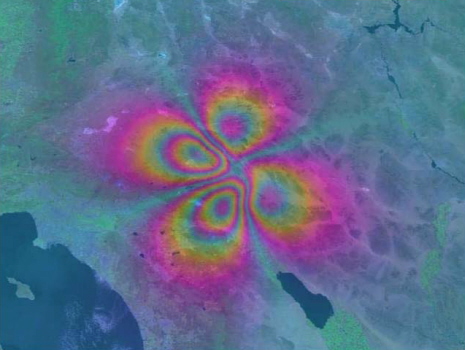
Cloverleaf
pattern of strain; compare to image D below.
GeoFEST computer
simulated postseismic surface
displacement from Landers earthquake
model after
500
years of viscoelastic relaxation, JPL-NASA

Polarized
light showing strain on plastic bar. Compare the yellow shape
to SFC-C below.
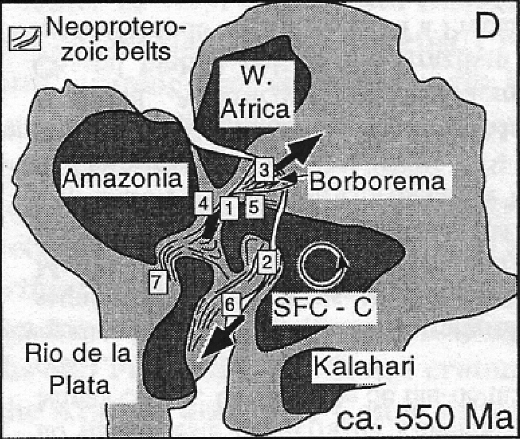
South
America and Africa before they separated. Note the cloverleaf
pattern of 4 cratons:
Amazonia, West Africa, Rio de la Plata,
and Sao Francisco-Congo, with intervening
collision belts (indicated
by numbered in boxes)
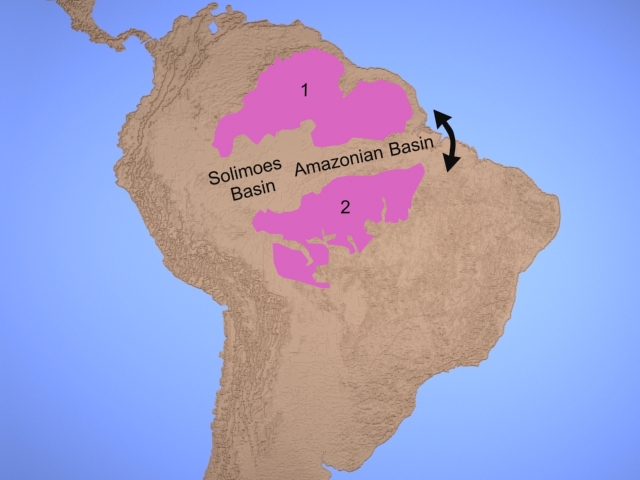
Rifting
of the Amazonian craton upon separation: 1 - Guiana Shield, 2 -
Guapore Shield
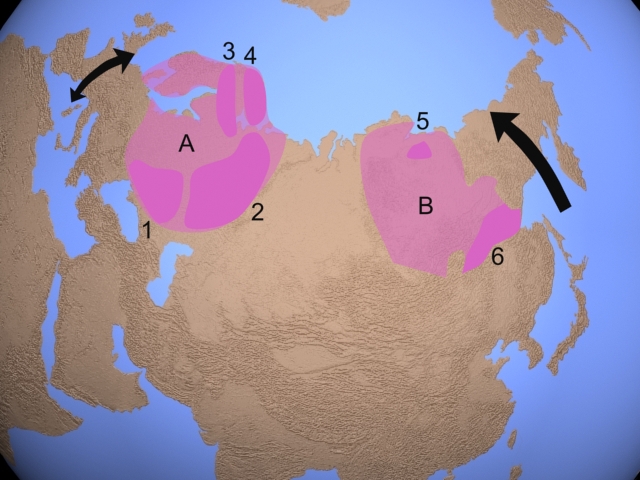
Pivot
stress in two places: A - Baltica, B - Siberia
1 - Sarmatia,
2 - Volga-Uralia, 3 - Karelia, 4 - Kola
5 - Anabar Shield, 6
- Aldan Shield
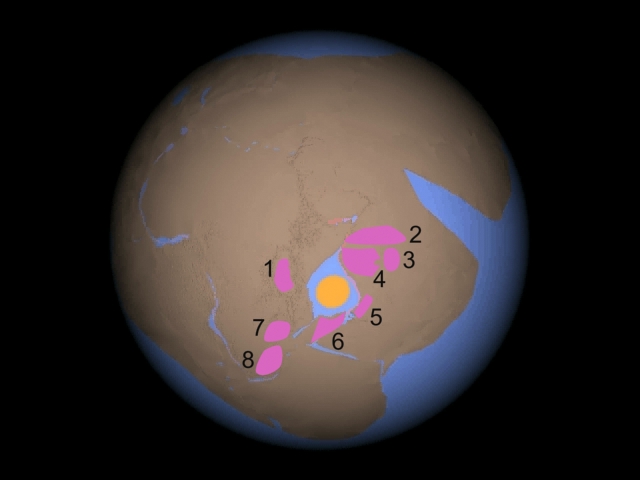
Individual
cratons surrounding the Shock Dynamics meteorite impact:
1 -
Tanzania, 2 - Dharwar, 3 - Pilbara, 4 - Yilgarn, 5 - Gawler
6 - Madagascar, 7 - Zimbabwe, 8 - Kaapvaal
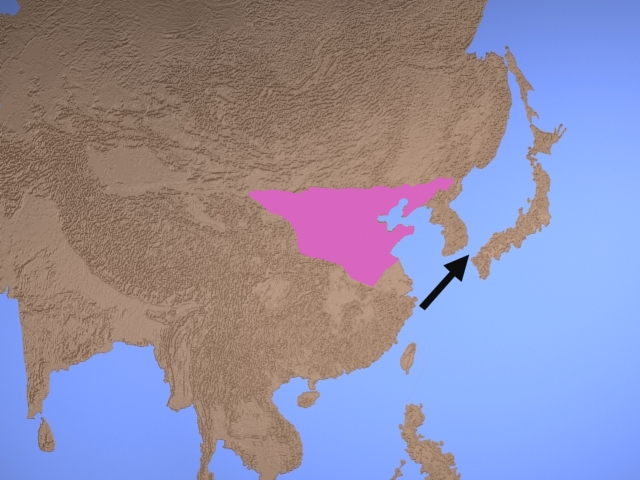
Extension
of the North China craton following compression (mountain building)
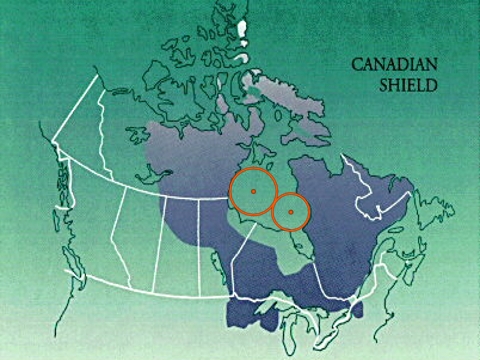
The
Canadian Shield was likely influenced
by the Hudson Bay meteorite
impacts
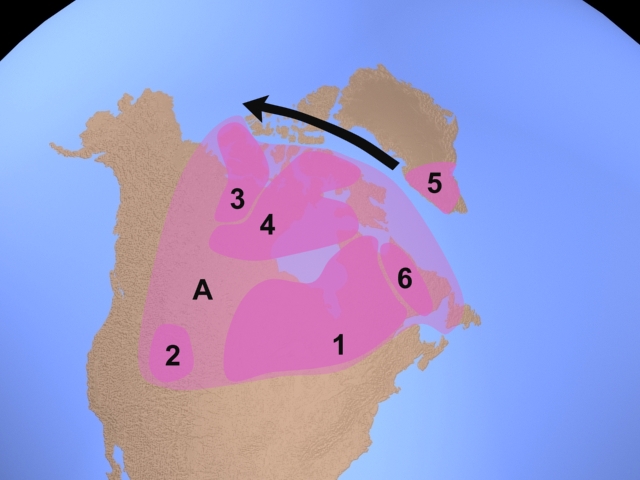
Westward
movement of North America opened the divide: A - Laurentia
1
- Superior, 2 - Wyoming, 3 - Slave, 4 - Rae-Hearne, 5 - Nain, 6
- Torngat orogen core
Thus all cratons would be a consequence of the Shock Dynamics event. Although stress on the protocontinent led to craton and proton formation, melting and founder of dense residue must have occurred after the motion of the continents (which lasted only about 26 hours) had ceased. The correlation of apparent isotopic age with the degree of melting (Proton=high, Archon=highest) suggests that widespread, intense melting during the Shock Dynamics event accelerated apparent aging, perhaps through transmutation by neutron capture (explained below).
Artificial radioisotope ages
Referring to work by Dr. Melvin Cook6, physical chemist
and former
professor of metallurgy at Utah University, science
writer Richard Milton wrote that Uranium decays to lead 207 and 206, and thorium to lead 208.
"There is another, and quite separate, mechanism by which common lead 204 can be
transmuted into a form which... will be indistinguishable from "radiogenic"
lead. This can occur through the capture of free neutrons"... from "a
radioactive ore deposit such as uranium, where they occur through spontaneous
fission." So the radioactive decay process not only produces radiogenic lead, it
also provides particles to turn common lead into radiogenic lead. This makes it
appear that the process has been going on for much longer than it has. "Lead 208
usually constitutes more than half the lead present in any given deposit. This
is normally interpreted as meaning that thorium... was very common in the
deposit." However, "the world's largest uranium ore deposits," in Zaire and
Canada, "contain practically no Thorium 232." The lead 208 "could have been
derived only from lead 207 by neutron capture." "All the so-called radiogenic
lead can be accounted for on the same basis." Rubidium-strontium "is subject to
exactly the same neutron capture process as uranium-lead." Strontium 86 can be
transformed to strontium 87. Strontium 87 occurs both as a daughter product of
radioactive decay and as a common element in rocks. "Typically, rocks contain
ten times more common than radiogenic strontium 87." Similarly, "Potassium 40
decays by capturing an electron and turning into the gas argon 40, with a
half-life of 1.3 billion years." "Argon 40 is a very common isotope in the
atmosphere and the rocks of the Earth's crust. Indeed, argon is the twelfth most
abundant chemical element on Earth and more than 99 percent of it is argon 40.
The possibility of inclusion of common argon with radiogenic "argon is not
merely conjecture but is borne out by numerous studies of volcanic rocks that
have resulted in false dates." Lavas from volcanic eruptions in recent
historical times in Hawaii as well as in New Zealand with wood inclusions
datable by radiocarbon show that the potassium-argon dates are off by hundreds
of thousands to millions to billions of years. "There is no truly independent
means of verifying the age of any given sample" other than a few exceptional
cases with historical records.29,
pp. 42-50
* * * * * * * * * * *
1. Amelin, Yuri. 23 December 2005. A Tale of Early Earth Told in Zircons. Science, Vol. 310, pp. 1914-1915.
2. Arndt, Nicholas T., Eric Lewin, Francis Albarede. 2002. Strange partners: formation and survival of continental crust and lithospheric mantle. in The Early Earth: Physical, Chemical and Biological Development, editors C.M.R. Fowler, C.J. Ebinger, C.J. Hawkesworth, Geological Society, London, Special Publications, 199, pp. 91-103.
3. Arndt, Nicholas T., Steven L. Goldstein. 1989. An open boundary between lower continental crust and mantle: its role in crust formation and crustal recycling. Tectonophysics, Vol. 161, pp. 201-212.
4. Cagnard, Florence, Nicolas Durrieu, Denis Gapais, Jean-Pierre Brun, Carl Ehlers. 2006. Crustal thickening and lateral flow during compression of hot lithospheres, with particular reference to Precambrian times. Terra Nova, Vol. 18, No. 1, pp. 72-78.
5. Carlson, Richard W., D. Graham Pearson, David E. James. 2005. Physical, chemical, and chronological characteristics of continental mantle. Reviews of Geophysics, Vol. 43, RG1001, pp. 1-24.
6. Cook, Melvin A. 1966. Prehistory and Earth Models. Max Parrish and Co. Ltd., London.
7. Davis, W.J., A.G. Jones, W. Bleeker, H. Grutter. 2003. Lithosphere development in the Slave craton: a linked crustal and mantle perspective. Lithos, Vol. 71, pp. 575-589.
8. Dixon, Jacqueline E., T.H. Dixon, D.R. Bell, R. Malservisi. 2004. Lateral variation in upper mantle viscosity: role of water. Earth and Planetary Science Letters, Vol. 222, pp. 451-467.
9. Djomani, Yvette H. Poudjom, Suzanne Y. O'Reilly, W.L. Griffin, P. Morgan. 2001. The density structure of subcontinental lithosphere through time. Earth and Planetary Science Letters, Vol. 184, pp. 605-621.
10. Durrheim, Raymond J., Walter D. Mooney. August 10, 1994. Journal of Geophysical Research, Vol. 99, No. B8, pp. 15,359-15,374.
11. Eaton, David W. 2005. Multi-genetic origin of the continental Moho: insights from Lithoprobe. Terra Nova, Vol. 18, No. 1, pp. 34-43.
12. Eiler, John M. 16 February 2007. On the Origins of Granites. Science, Vol. 315, pp. 951-952.
13. Enderle, U., M. Tittgemeyer, M. Itzin, C. Prodehl, K. Fuchs. 1997. Scales of structure in the lithosphere -- images of processes. Tectonophysics, Vol. 275, pp. 165-198.
14. Fuchs, Karl, Marc Tittgemeyer, Trond Ryberg, Friedemann Wenzel, Walter Mooney. 2002. International Geology Review, Vol. 44, pp. 671-685.
15. Griffin, W.L., Suzanne Y. O'Reilly, B.J. Doyle, N.J. Pearson, H. Coopersmith, K. Kivi, V. Malkovets, N. Pokhilenko. 2004. Lithosphere mapping beneath the North American plate. Lithos, Vol. 77, pp. 873-922.
16. Griffin, W.L., S. Y. O'Reilly, N. Abe, S. Aulbach, R.M. Davies, N.J. Pearson, B.J. Doyle, K. Kivi. 2003. The origin and evolution of Archean lithospheric mantle. Precambrian Research, Vol. 127, pp. 19-41.
17. Handy, M.R., J.-P. Brun. 2004. Seismicity, structure and strength of the continental lithosphere. Earth and Planetary Science Letters, Vol. 223, pp. 427-441.
18. Heintz, Maggy, Eric Debayle, Alain Vauchez. 2005. Upper mantle structure of the South American continent and neighboring oceans from surface wave tomography. Tectonophysics, Vol. 406, pp. 115-139.
19. Herzberg, Claude. 1999. Phase equilibrium constraints on the formation of cratonic mantle. in Mantle Petrology: Field Observations and High Pressure Experimentation: A Tribute to Francis R. (Joe) Boyd, editors Yingwei Fei, Constance M. Bertka, Bjorn O. Mysen, The Geochemical Society, Special Publication No. 6, pp. 241-257.
20. Jull, M., P.B. Kelemen. April 10, 2001. On the conditions for lower crustal convective instability. Journal of Geophysical Research, Vol. 106, No. B4, pp. 6423-6446.
21. Kaban, Mikhail K., Peter Schwintzer, Irina M. Artemieva, Walter D. Mooney. 2003. Density of the continental roots: compositional and thermal contributions. Earth and Planetary Science Letters, Vol. 209, pp. 53-69.
22. Kelly, Robyn K., Peter B. Kelemen, Matthew Jull. 18 February 2003. Buoyancy of the continental upper mantle. Geochemistry Geophysics Geosystems, Vol. 4, No. 2, pp. 1-24.
23. King, Scott D. 2005. Archean cratons and mantle dynamics. Earth and Planetary Science Letters, Vol. 234, pp. 1-14.
24. Kroner, Alfred, Umberto Cordani. 2003. African, southern Indian and South American cratons were not part of the Rodinia supercontinent: evidence from field relationships and geochronology. Tectonophysics, Vol. 375, pp. 325-352.
25. Lee, Cin-Ty Aeolus. 2006. Geochemical/Petrologic Constraints on the Origin of Cratonic Mantle. in Archean Geodynamics and Environments, Geophysical Monograph Series 164, editors Keith Benn, Jean-Claude Mareschal, Kent C. Condie, pp. 89-114.
26. Lee, Cin-Ty Aeolus, Adrian Lenardic, Catherine M. Cooper, Fenglin Niu, Alan Levander. 2005. The role of chemical boundary layers in regulating the thickness of continental and oceanic thermal boundary layers. Earth and Planetary Science Letters, Vol. 230, pp. 379-395.
27. Lenardic, A., L.-N. Moresi, H. Muhlhaus. 2003. Longevity and stability of cratonic lithosphere: Insights from numerical simulations of coupled mantle convection and continental tectonics. Journal of Geophysical Research, Vol. 108, No. B6, pp. ETG 9 - 1-15.
28. Meert Joseph G., Trond H. Torsvik. 2003. The making and unmaking of a supercontinent: Rodinia revisited. Tectonophysics, Vol. 375, pp. 261-288.
29. Milton, Richard. 1997. Shattering the Myths of Darwinism. Park Street Press, Rochester, Vermont.
30. Mooney, Walter D., John E. Vidale. 2003. Thermal and chemical variations in subcrustal cratonic lithosphere: evidence from crustal isostasy. Lithos, Vol. 71, pp. 185-193.
31. Nitescu, B., A.R. Cruden, R.C. Bailey. 2006. Crustal structure and implications for the tectonic evolution of the Archean Western Superior craton from forward and inverse gravity modeling. Tectonics, Vol. 25, TC1009, pp. 1-16.
32 Niu, Fenglin, David E. James. 2002. Fine structure of the lowermost crust beneath the Kaapvaal craton and its implications for crustal formation and evolution. Earth and Planetary Science Letters, Vol. 200, pp. 121-130.
33. Kochemasov, G.G. 1983. The Congo craton: an old impact structure? Lunar and Planetary Institute, NASA Astrophysics Data System.
34. Silver, Paul G., Mark D. Behn, Katherine Kelley, Mark Schmitz, Brian Savage. 2006. Understanding cratonic flood basalts. Earth and Planetary Science Letters, Vol. 245, pp. 190-201.
35. Sleep, Norman H. 2005. Evolution of the Continental Lithosphere. Annual Review of Earth and Planetary Science, Vol. 33, pp. 369-393.
36. Sleep, Norman H. 2003. Survival of Archean cratonal lithosphere. Journal of Geophysical Research, Vol. 108, No. B6, pp. ETG 8 - 1-29.
37. Thybo, H., E. Perchuc. 14 March 1997. The Seismic 8 degree Discontinuity and Partial Melting in Continental Mantle. Science, Vol. 275, pp. 1626-1629.
38. Van der Velden, Arie J., Frederick A. Cook, Barry J. Drummond, Bruce R. Goleby. 2006. Reflections of the neoarchean: A global perspective. Archean geodynamics and environments, Vol. 164, pp. 255-265.
39. Vigneresse, Jean Louis. 2004. A new paradigm for granite generation. Transactions of the Royal Society of Edinburgh: Earth Sciences, Vol. 95, pp. 11-22.
40. Vinnik, Lev, Veronique Farra. 2002. Subcratonic low-velocity layer and flood basalts. Geophysical Research Letters, Vol. 29, No. 4, pp. 8 - 1-4.
41. Watson, E.B., T.M. Harrison. 6 May 2005. Zircon Thermometer Reveals Minimum Melting Conditions on Earliest Earth. Science, Vol. 308, pp. 841-844.
42. Weeraratne, Dayanthie S., Donald W. Forsyth, Karen M. Fischer, Andrew A. Nyblade. 2003. Evidence for an upper mantle plume beneath the Tanzanian craton from Rayleigh wave tomography. Journal of Geophysical Research, Vol. 108, No. B9, pp. ESE 10 - 1-17.
43. Wittig, N., D.G. Pearson, M. Webb, C.J. Ottley, G.J. Irvine, M. Kopylova, S.M. Jensen, G.M. Nowell. 2008. Origin of cratonic lithospheric mantle roots: A geochemical study of peridotites from the North Atlantic Craton, West Greenland. Earth and Planetary Science Letters, Vol. 274, pp. 24-33.
44. Zheng, Jianping, W.L. Griffin, Suzanne Y. O'Reilly, Ming Zhang, Norman Pearson, Yuanming Pan. June 2006. Widespread Archean basement beneath the Yangtze craton. Geology, Vol. 34, No. 6, pp. 417-420.

